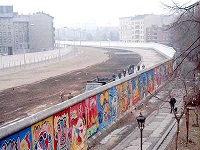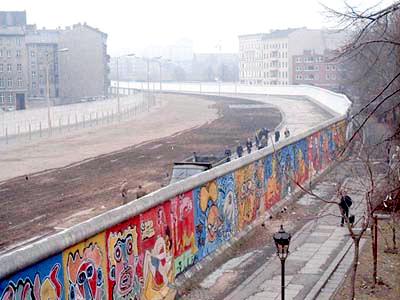
On August 13, 1961 a wall was built to divide the city of Berlin. The excuse for the wall was to keep westerners out of East Berlin, but the real reason was to keep people from defecting out of Communist rule into the free world. The Berlin Wall became a symbol of Cold War tensions between the US and the Soviet Union that lasted for 28 years until 1989 when free passage between East and West Berlin was finally allowed and the Berlin Wall came down. What was the real story of the Berlin Wall and how do we live with its legacy today?
Modern history of the city of Berlin really began in the settlement after World War II. The Pottsdam Agreement was an agreement settled on by the 4 main allies in WWII - the US, Britain, France, and the Soviet Union. Germany was to be divided up into 4 occupation zones with the Soviet Union holding the eastern part of Germany where Berlin was located. Berlin was similarly divided up into 4 sections, with the western part to be controlled by the US, Britain, and France and the eastern part by the Soviet Union. This meant that allied zones within Berlin would sit right in the middle of Soviet controlled East Germany.
As the agreement took shape, it became clear that Berlin provided a pathway out of the Soviet controlled East Germany that many would take advantage of. This was the beginning of the Cold War. West Berlin and West Germany were free societies modelled after the US and Western Europe. East Germany was an authoritarian state controlled land taking its orders from Moscow. What's more, the Soviet Union began taking all of the natural resources out of East Germany to support the rebuilding of the Soviet Union. With the border open between East and West Berlin, the incentive to leave the Soviet controlled area was immense, and refugees poured into West Berlin to start a life there or to move to other parts of West Germany.
The exodus this didn't sit well with authorities in Moscow, and in 1948 they moved to close off access to and from West Berlin by imposing a land blockade of West Berlin. They would starve out the allies from West Berlin and bring all of Berlin under Soviet control. The US and its allies would not go to war over Berlin, but they did have a solution which was to drop food, fuel, and supplies from the air to the isolated population of West Berlin. This became known as the Berlin Airlift. For 11 months between 1948 and 1949 the allies dropped supplies in to meet all of the needs of West Berlin. There was a flight every 2 minutes. Eventually in 1949 the Soviets backed off of their blockade having failed to drive the allies out of West Berlin.
For the next 12 years leading up to 1961, the West continued to accept refugees, while the Soviets searched for way to stop them. The economy of East Germany suffered as over 3 million people left East Germany, many of them young and well educated. East Germany was losing its labor force. They could not train their workers fast enough to compensate for those who were leaving. The border between East and West Germany was closed with barbed wire fencing and border guards, however travel between East and West Berlin was unrestricted so those who chose to leave could travel to West Berlin, then freely exit the East bloc from there. By 1961, East Germany had lost nearly 20% of its population. East German and Soviet leaders publically denied any plans to build a barrier between East and West Berlin, but secretly plans were underway.
On August 12, 1961, Soviet leader Khrushchev gave the order to build the barrier and construction began of the cement and barbed wire wall that would last for the next 28 years. It would now be impossible to pass between East and West Berlin without going through one of the checkpoints. Family and friends were split up, depending on which side of the wall they were. One street, Bernauer Strasse, was located right where the wall was built, so the entrances and windows actually resided on the west side. A number of brave souls jumped out of their windows to reach the west side, and on August 22 Ida Siekmann became the first casualty of the wall when she perished trying to jump out of her window.
The wall was progressively reinforced with more concrete and barbed wire, making it more difficult for east side dwellers to escape. Guards patrolled the wall 24 hours a day and were under orders to shoot to kill anyone who tried to escape. In the early days escapes were fairly frequent as escapees scaled the wall, dug tunnels, or drove large vehicles through the unfortified areas. A number of the escapees were the guards themselves. Some were not so lucky, like teenager Peter Fechter. In an attempt to scale the wall with his partner Helmut K, Fechter was shot and left to badly injured while East German guards and police on the West side refused to help him for fear that they too would be shot or would trigger an escalation of the military conflict.
President Kennedy, while obviously not happy with the construction of the wall, considered it a better option than war. On June 26, 1963, Kennedy visited West Berlin and made one of his most famous speeches in support of the people of Berlin.
All free men, wherever they may live, are citizens of Berlin, and therefore, as a free man, I take pride in the words "Ich bin ein Berliner!"
The speech strengthened the alliance between the US and Berliners, who stuck in the middle of Communist territory continually feared that their little space of freedom would be taken over.
One interesting note - while the speech was widely acclaimed throughout the US and the rest of the free world, there was some debate about the literal translation of "Ich bin ein Berliner!" Though the speech was carefully crafted with the help of an expert translator, the use of the article "ein" made it possible to translate the phrase as "I am a jelly doughnut!" Berliners who heard the speech clearly did not misunderstand its meaning.
The Cold War raged on through the 1960s and 1970s. The Berlin Wall was continually upgraded to make it more difficult to escape. By 1980, the wall was 12 feet high and 3.9 feet wide with smooth piping at the top, to make it nearly impossible to scale, even if you weren't shot by one of the guards or taken down by the vicious dogs that guarded the wall. In 1979 the families of Strelczyk and Gunter Wetzel put together propane cylinders and old bed sheets to create a makeshift hot air balloon. Together with their wives and children they floated over the wall to freedom.
By 1987, Soviet leader Mikhail Gorbachev was intent on moving the Soviet Union and the Eastern bloc ahead with more openness and a freer economy than before. That year, another US President made a speech in West Berlin challenging the wall. On June 12, 1987, President Reagan spoke the following words at the Brandenburg Gate:
General Secretary Gorbachev, if you seek peace, if you seek prosperity for the Soviet Union and eastern Europe, if you seek liberalization, come here to this gate. Mr. Gorbachev, open this gate. Mr. Gorbachev, tear down this wall!
Reagan's speech was a sign of things to come. In 1989, the border between Hungary and Austria was partially opened, and East German tourists visiting Hungary began escaping to Austria. Then a similar border opening in Czechoslovakia allowed more East Germans to escape and by September, 1989 massive protests had broken out in East Germany with people shouting "Wir wollen raus!" ("We want out!"). Iron fist leader of East Germany Erich Honecker resigned in October, and the new leadership decided it was time to open the border. On November 9 it was announced that travel between East and West would be allowed for the first time in 28 years. While they neglected to tell the border guards, the checkpoints were opened peacefully with no incident as the joyful Germans were united between East and West. Some celebrants wielded sledgehammers to take down parts of the wall that had separated the Berlins. Shortly after this historic day, on October 3, 1990 East and West Germany were officially reunited.
One man who was not happy about the fall of the wall and German reunification was a young KGB spy stationed in Dresden, Germany named Vladimir Putin. To Putin, the loss of the Soviet Union's iron grip on the Eastern bloc was a disaster. KGB leaders even attempted a coup-de-ta in 1991 attempting to overthrow Gorbachev. The Soviet Union actually dissolved in 1991 leaving Russia and its former satellites as independent countries. However, after years of experimenting with a somewhat free society under Boris Yeltsin, Russia gained a new leader in 1999 in former KGB spy Vladimir Putin. From 2000 until today, Putin has been either President or Prime Minister of Russia, piece by piece rekindling the "glory" days of the USSR by restricting freedom of speech and press and annexing parts of its neighbors such as Crimea. We can only hope that the history of the Berlin Wall will never repeat itself.













SUBMIT A COMMENT